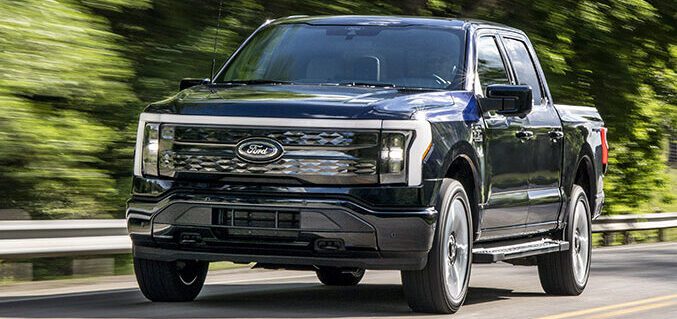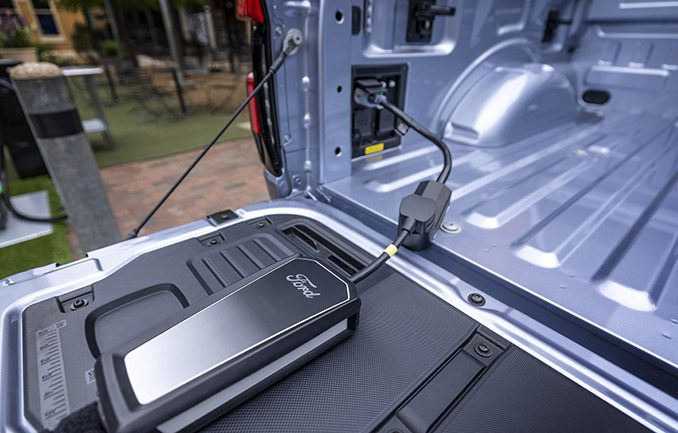
SAN ANTONIO — The Ford F-150 Lightning is the most important electric car ever made. It’s also the most important pickup truck ever made.
A pickup truck is the ultimate “but I might” vehicle. But I might need to haul furniture. But I might need to drive to grandma’s house while towing an 8,000-lb boat. But I might need to conquer some off-road obstacles.
Ford knows all this and knows its truck customers. It’s what Built Ford Tough means, and though it’s easy to dismiss that as a silly marketing slogan, it means something at Ford, and they aren’t going to put a truck on sale unless it lives up to that billing.
And so, when Ford decided to release an electric pickup truck, the designers and engineers knew they needed to add capability. It wasn’t enough to make it electric and put it on sale like they did with the Ford E-Transit commercial van. It needed to add capabilities that were only possible with an electric truck.
The Ford F-150 Lightning is filled with clever features that wouldn’t be possible in a more traditional vehicle.
Up front is the Mega Power Frunk (Ford loves over-the-top names for things). Since you don’t have an engine, there’s room under the hood to put stuff. But company engineers showed me how simply removing the engine wouldn’t allow for the enormous, 400-liter storage compartment. There’s a lot of equipment under the hood that you need in an EV, like radiators, power steering equipment, suspension components, brakes, and all manner of things — and they all needed to be moved to maximize frunk space.

This was important because Ford’s market research showed that one of the main concerns of truck buyers is having lockable, weatherproof storage. Sedans and SUVs have trunks and cargo compartments, but a pickup truck has a big, open bed that’s tempting to thieves and tempting the weather unless you buy a bed cap or tonneau cover, which have their own annoyances.
The Mega Power Frunk has a flat load floor and includes multiple residential 120-volt power outlets and several USB ports to charge up all your gear. The possibilities for these power outlets are endless, from charging up laptops and backup batteries (both of which I did in my testing) to powering ski boot warmers or rechargeable power tools.
There’s an extra storage compartment in the bottom of the frunk with a drain plug, so you can fill the container with ice and have first-rate drink storage for your next tailgate — though, is it still called a tailgate if you’re using the front of your truck?
Get these reviews in your email every week with Jordan Golson’s free car reviews newsletter.
Pro Power Onboard is another clever feature, though this is one that’s also included in the internal-combustion F-150. It provides power outlets in the frunk and bed to offload 9.6 kilowatts of electricity. That’s more than 10 hours at full speed, which is a mind-boggling amount of power.
The cleverest part is that Pro Power Onboard includes a 240-volt power outlet, meaning the Lightning can charge another EV at 7.2 kW. That’s more than enough to save a stranded friend who didn’t quite make it to the nearest charger. The Lightning can even be plugged into itself, though you get some efficiency loss as Ford couldn’t quite figure out how to make that elusive perpetual motion machine.

While charging a car is impressive, charging a house can be a game-changer for a lot of potential truck buyers. Power outages are rare, but things can go from annoying to dangerous in a hurry if they extend beyond a few hours. That’s why many people have diesel or propane-powered generators.
The F-150 Lightning can power an entire house if you install the right equipment. Ford says a fully-charged Lightning can power the average home for three days, and this can be extended to as long as ten days if you only need the essentials.
Not many folks want or have the ability to install a propane-fired generator, but if you can take advantage of the enormous store of power already sitting in your garage, why wouldn’t you? Home battery storage is becoming increasingly popular, but it becomes a lot more enticing if that storage can double as a pickup truck with a 320-mile range. This feature alone will sell a lot of electric trucks in rural areas, and it should be price competitive with a typical residential generator.
Ford has more than 200,000 reservations for the F-150 Lightning, which will take more than a year to fill, and it stopped taking reservations for a while as the company works to ramp up production.
Three-quarters of those reservation holders are new to Ford, almost 80 percent are new to EVs, and half are new to trucks. Those impressive numbers show that not only is the F-150 Lightning introducing truck buyers to EVs in remarkable numbers, but it’s also bringing a lot of new people to trucks.
In almost every way, the F-150 Lightning feels like a regular F-150. Aside from tweaks to the head and taillights, it looks basically the same to anyone but a truck enthusiast, though every body panel has been reworked slightly to improve aerodynamics.
The interior shares much, including seats, center console, and most of the dash, with the standard F-150. The only significant change is the massive, vertical 15-inch center screen that replaces most physical radio and climate controls.
And it drives like a truck, too, albeit one with a ton of weight down low. But I took a Lightning onto a dirt autocross course and found it to be predictable and controllable, and even during some spirited backroad driving, I didn’t feel like the big truck was leaning all that much in the corners.

In many ways, the most surprising thing about the F-150 Lightning was how unsurprising it was. I’ve driven many different F-150 models, from the Raptor to the Hybrid to the standard V8, and though there are significant differences in powertrain, they all share a common lineage and feel. And the Lightning fits in perfectly with the rest of the family.
It feels like a Ford F-150 that happens to be electric rather than an electric F-150. Ford has taken the formula that’s made the F-Series the best-selling vehicle line in the country for more than four decades and created a new Built Ford Tough electric version.
And I haven’t even gotten into the absurd performance numbers. The dual-motor extended-range battery pack produces 580 hp and 775 lb-ft of torque, and it’s good for 320 miles of range. That makes it one of the most potent F-150s ever, and it’s almost unnecessarily quick under max acceleration.
Ford says the F-150 Lightning is good for a 0-60 mph run in the mid-4.5-second range. In my testing, that claim is accurate. It’s honestly mind-blowing to have a truck move that quickly and silently.
Properly equipped, the truck can tow a maximum of 10,000 pounds (on the XLT and Lariat with extended-range battery and Max Trailer Tow Package) and a maximum payload of 2,235 pounds.
The standard-range battery, by the way, is good for 230 miles and 452 hp, though with the same torque number because of the oddities of electrical powertrains, and there’s about a $10,000 premium between the two.
The work-focused Pro trim starts around $40,000 for the standard range, but it includes the standard crew cab and a 12-inch central touchscreen with all the communication and telematics that companies need — and consumers can buy it too.
If you want more comfort, luxury, and capability, you can opt for XLT, Lariat, and Platinum models, the latter of which can climb above $90,000 if you check all the boxes, so if you want an electric truck between $40,000 and $90,000, you can do it. And, for now, at least, Ford has yet to run out its $7,500 federal tax credit, but if you order a new Lightning today, you might not be eligible for it by the time it arrives.
The F-150 Lightning looks like a truck and drives like a truck but has incredible features made possible by its electric powertrain. But I can’t help but wonder: if this is what Ford came up within its first attempt… what’s the next electric F-150 going to have?
